Sago
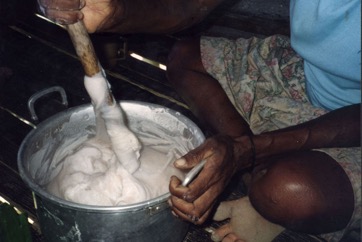
A tropical plant. A high water-table is tolerated or required by the plant. Temporary flooding does not appear to affect the crop but permanently flooded sites do not appear to be suitable. Because of the site requirements sago is almost always on locally level ground. The level ground can be a broad flat basin or flood plain or a local depression or stream edge in more dissected terrain. Sago seedlings are hardly harmed, by one rather saline flooding, per fortnight. Sago seedlings can probably withstand a salinity of EC = 10mmho/cm. The maximum altitude is about 1200 m but the optimum is between sea level and 800 m. Sago palms grow well in wet conditions. It can tolerate saline or brackish water. It grows better in well drained than in poorly drained conditions. It grows best with a temperature of about 25°C. It cannot tolerate temperatures below 17°C. It suits hardiness zones 11-12. They are widely distributed in the central and southern Philippines. They are especially abundant in the fresh water swamps of the Agusan Valley in Mindanao. They also occur in Papua New Guinea and Indonesia.
Also known as:
Ambasao, Ambulung, Ambusao, Asiba, Balau, Bulu, Bulung, Chr ae saku, Epawe, Ewa, Hau, Hiwa, Hiywa, Kawi, Kersula, Kirai, Kogi, Kresula, Kui, Lumbia, Men, Mene, Nolu, O, Palma de sago, Pohon rumbia, Pohon sagu, Rajang bunkoan, Rambia, Rembi, Rembia, Rembulung, Resula, Rontan, Rumbia, Sa khu, Sago yashi, Sagopalme, Sagoutier, Sagu, Saksak, Tembulu, Tha-gu-bin, Wa ha'ro, Xi mi zong
Synonyms
- Metroxylon hermaphroditum Hassk.
- Metroxylon inerme (Roxb.) Mart.
- Metroxylon laeve (Giseke) Marte
- Metroxylon longispinum (Giseke) Mart.
- Metroxylon micracanthum Mart.
- Metroxylon oxybracteatum Warb. ex K. Schum. & Lauterb,
- Metroxylon rumphii (Willd.) C. Martius
- Metroxylon squarrosum Becc.
- Metroxylon sylvestre (Giseke) Mart.
- Sagus americana Poir.
- Sagus genuina Giseke
- Sagus inermis Roxb.
- Sagus koenigii Griff.
- Sagus laevis Jack
- Sagus longispina (Giseke) Blume
- Sagus micrantha (Mart.) Blume
- Sagus rumphii Willd.
- Sagus sagu (Rottb.) H. Karst.
- Sagus spinosus Roxb.
- Sagus sylvestris (Giseke) Blume
Edible Portion
- Starch, Cabbage, Palm heart, Grubs
Where does Sago grow?
Found in: Asia, Australia, Cambodia, China, East Timor, Fiji, Guam, India, Indochina, Indonesia, Malaysia, Micronesia, Myanmar, Northeastern India, Pacific, Palau, Papua New Guinea, PNG, Philippines, Samoa, SE Asia, Singapore, Solomon Islands, Thailand, Timor-Leste, Vietnam, West Papua
Notes: There are 8 Metroxylon species. Sago Sago is the staple food in the Kutubu area and is an important subsidiary staple in a number of the lowland areas. The sago palms are planted from suckers into land just slightly too wet for gardening. The palm matures after about 15 years and is cut down. The starch inside the pith of the trunk is removed by shredding the fibrous pith then extracting the starch by washing and pounding the fibre. A palm is processed in sections about 1m long and this provides the sago for a family for 2 or 3 days. A palm lasts for about 4 weeks. An important supplement is the sago grubs that are cultivated in the end sections of the palm and in unwanted palms. The palm shoot is edible. Sago growing The best conditions for growing sago are an average temperature of at least 26°C, a relative humidity of at least 90% and an irradiance of about 9MJ/m2 per day. Daily flooding is harmful to seedling growth. Sago palms grow best on mineral soils with a high organic matter content (up to 30%). As water becomes more brackish, sago palm often border on stands of more salt tolerant nipa palm. The water table should not be lower than 50 cm. Root suckers about 1 year old with a basal diameter of 10-15 cm are severed from the parent palm. About 15 cm of runner are left on the sucker to serve as food reserve. The cut wound is rubbed with wood ash to prevent rots. Roots need to be kept from drying out. A spacing of 7m x 7m is suitable in a 30 cm deep hole. Suckers should be staked and shade provided. One sucker per 1.5 years should be allowed to develop. For maximum starch production trunks are cut between flower initiation and the ripening of the fruit. An ongoing yield of about 85 trunks per hectare of 180 kg each per year can be achieved but a more normal yield from minimally managed stands is 50 trunks per hectare producing 10 t/ha. Processing involves three stages. 1. Separation of bark and pith. 2. Pulverisation of the pith. 3. Separation of starch from pith. Sepik estimate as 500,000 ha. Sago plants become permanently stunted as the swamps become deeper. Also stunted sago occurs on sites where the water table sinks low enough to cause drought stress. These kinds of sago sucker strongly.
Status: A very important staple food in several swampy coastal areas of Papua New Guinea.
Growing Sago
Cultivation: Suckers or seedlings are planted in fresh water swamps or along creeks. Once stands are established in swamps, they continue to re-grow from suckers. Plants are thinned by removing some suckers. Some “seeds” will not grow but those that are fertile need to be planted as soon as they form because they loose their viability. Seeds germinate within 3 weeks. To plant sago, the planting site near a creek or in a damp place, is first cleared of trees and rubbish. Then a sucker of a suitable variety is chosen from an old sago clump. Often the fronds of the sucker are up to 3 m high. It is first checked to see if the sucker is old enough. Suckers ready for planting have a tough woody connection to the base of the old palm. It is also checked to see that fresh roots are being produced from the base of the sucker. A suitable sucker probably has fronds 3-4 m long and is about 1.5 years old. This is chopped through with an axe. The sucker is then simply taken to a new site and planted in a shallow hole 30 cm x 30 cm x 30 cm. If several palms are being planted, they should be about 7 m apart. The only other attention the new palm needs is an occasional weeding to cut back rubbish when it gets too thick. If a suitable seedling is available it can be replanted where it is wanted. Several informants estimated that approximately 50% of transplanted suckers died. The suggested reasons were either choice of an immature sucker or climatic variability, especially drought. (Because of a general lack of awareness of disease organisms by Papua New Guinea farmers, these should not be ruled out.) If a seedling palm, as opposed to a sucker, was available for transplanting, it was considered to be equally suitable. Apart from walking time and site clearing, if needed, the work involved in planting a sago took about 10 minutes. Once planted the sago groves renew themselves through suckers and an almost permanent stand is produced. The optimum spacing is considered to be 275 clumps per hectare. In most naturally established stands this would be thinner than that which occurs. It is also considered that for one clump thinning out suckers so that 3 suckers only of different ages were maintained to give optimum harvestable yield. Higher yields per trunk reduce the amount of labour involved in processing the pith. The type of site chosen was just marginally too damp for gardening of annual vegetables, but not permanently inundated It takes 12 to 15 years for a sago palm to grow big enough to cut down. Palms in poor soil grow more slowly. Normally, one main trunk grows up, but several small suckers may shoot up around the base. Sometimes these suckers spread out and the space between the palms becomes crowded. Too much competition between clumps slows down the growth of the main palm, so the grove needs to be thinned out. This is very easily done. A small hole (10 cm x 10 cm) is cut with an axe into the top of the trunk of a sucker that is not wanted. This hole lets the sago beetle in and the sago grubs which develop quickly kill out the sucker. They don't get into the main palm or other suckers unless a hole is made. After a few months when the sucker is seen to be dead it can be split open to provide a feed of sago grubs. There is no simple way of telling when a palm is ready to harvest. By experience people learn to recognise how big each variety should be before it is ready to harvest. If the palm were left too long it would produce a very large flower at the top and then die. This flower would use up all the starch in the trunk so that there would be nothing to harvest. As long as the flower has only started to grow and the seeds haven't yet formed on it, the palm is still suitable for harvesting. Sometimes when people are in a hurry to use a palm which isn't quite ready, they cut a hole to check how much starch is stored inside. But sago grubs must not be allowed to get in. It is considered that improvement in predicting the time for harvesting could be made by choosing trunks with at least 50 leaf scars on the trunk, with short internodes between the leaf scars and with a higher circumference. After the palm has been cut and harvested another sucker grows more quickly than the others and becomes the new main trunk. It still takes about the same time to get mature. On some soil types such as where there is a clay pan and the soil is regularly flooded the palm can take up to 10 years longer to reach maturity.
Edible Uses: The bud can be eaten cooked. Sago starch can be processed from the pith. The sap can be collected for a drink called “tuba” in the Philippines Sago grubs are often cultivated and eaten.
Production: Palms are ready to harvest after about 15 years. In swamps, about 10 to 60 trunks are ready per hectare each year. An average processing rate is 2.2 kg/hr of starch. A single trunk can yield up to 400 kg of sago. First the sago palm is cut down. Mostly this is men's work. Then the bark is split off the trunk for about one metre along its length. Normally this bark is carefully laid out at the sides propped up by logs so that it both makes a seat for the person to sit on and a mat for the shredded pith of the trunk to fall onto. Sago in the trunk of the palm is all mixed up with the fibres of the plant. So this pith has to be shredded up into small pieces and the starch is then washed out. Special tools are made for pounding up the trunk. They need to be light, strong and with a hard stone (or metal) head. In areas where sago is the main food, sago is women's work. The woman sing special songs while they work. In areas where sago is not the main food, both men and women pound sago. When a pile of shredded up trunk has been made, it is carried away to be washed. If a lump of the pith breaks off it is often chopped up with a bush knife or axe. A framework is set up for washing sago. It needs to be near water. If no convenient creek is nearby, a hole can be dug in the ground as this quickly fills with water in most sago places. The water needs to be clean or the starch gets a bad colour and taste. The shredded pith of the palm is put into the bowl made by the fronds and the starch is washed out by banging it with a stick and pouring water over it. The filtered starch is allowed to settle out in a bowl. It is then dried and taken home It takes about one hour to pound enough sago, then wash out the starch, sieve it and allow the starch to settle to give between 2 and 3 kilograms of starch. Some people store sago for long periods. The sago to be stored is wrapped up in a tight bundle using leaves and bark. It is then buried in the mud. It will keep for one or two years. Sago which has been stored has a slightly different taste, but it is still quite good to eat. In some areas people store sago for up to 6 months by drying it above the fire or in the sun. When they want to use it they simply add water and cook it. The taste is little changed by this drying process. Some people store sago in the trunk of the palm by removing the flower just as it starts to develop and the sago in the trunk can be left for a year or more before harvesting. As well other people put the fallen sago log under water and store the unprocessed sago this way for several weeks. The starch can be used to produce alcohol for motor fuel. One ton of starch produces about 73 gallons of alcohol.
Nutrition Info
per 100g edible portion| Edible Part | Energy (kcal) | Protein (g) | Iron (mg) | Vitamin A (ug) | Vitamin c (mg) | Zinc (mg) | % Water |
|---|---|---|---|---|---|---|---|
| Trunk starch | 286 | 0.2 | 0.7 | - | 0 | - | 27 |
| Palm heart | 43 | 1.8 | 0.2 | 0 | 2 | 0.5 | 91 |
Sago Photos

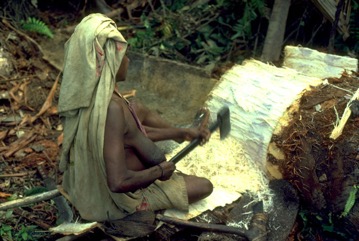
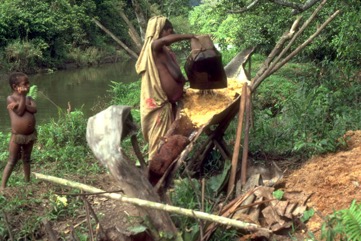
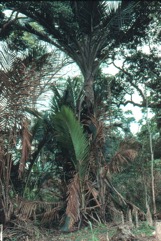
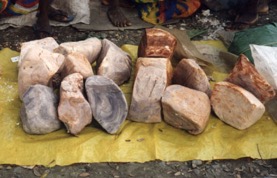
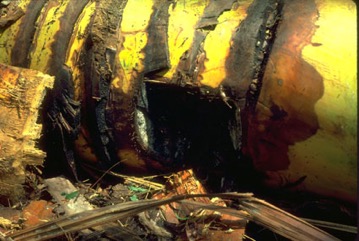
References
Ambasta, S.P. (Ed.), 2000, The Useful Plants of India. CSIR India. p 368
Arora, R. K., 2014, Diversity in Underutilized Plant Species - An Asia-Pacific Perspective. Bioversity International. p 105
Baker, W.J. and Dransfield, J., 2006, Field Guide to Palms of New Guinea. Kew p 82
Balick, M.J. and Beck, H.T., (Ed.), 1990, Useful palms of the World. A Synoptic Bibliography. Colombia p 298, 553,
Barrau, J., 1959, The sago palms and other food plants of marsh dwellers in the South Pacific Islands. Economic Botany 13(2):151-162.
Massal, E and Barrau, J., 1973, Food Plants of the South Sea Islands. SPC Technical Paper No 94. Noumea, New Caledonia. p 3 As Metroxylon oxybracteatum)
Barrau, J., 1960, The sago palms. Principes 4(2):44-53
Balick, M.J. and Beck, H.T., (Ed.), 1990, Useful palms of the World. A Synoptic Bibliography. Colombia p 98, 143, 460,
Blomberry, A. & Rodd, T., 1982, Palms. An informative practical guide. Angus & Robertson. p 124
Bodkin, F., 1991, Encyclopedia Botanica. Cornstalk publishing, p 698
Borrell, O.W., 1989, An Annotated Checklist of the Flora of Kairiru Island, New Guinea. Marcellin College, Victoria Australia. p 38
Burkill, I.H., 1966, A Dictionary of the Economic Products of the Malay Peninsula. Ministry of Agriculture and Cooperatives, Kuala Lumpur, Malaysia. Vol 2 (I-Z) p 1485
Cobley, L.S. (rev. Steele, W.M.) 2nd Ed., 1976, An Introduction to the Botany of Tropical Crops. Longmans. p 128
Cowie, I, 2006, A Survey of Flora and vegetation of the proposed Jaco-Tutuala-Lore National Park. Timor-Lests (East Timor) www.territorystories.nt/gov.au p 43
Cundall, P., (ed.), 2004, Gardening Australia: flora: the gardener's bible. ABC Books. p 893
Elevitch, C.R.(ed.), 2006, Traditional Trees of the Pacific Islands: Their Culture, Environment and Use. Permanent Agriculture Resources, Holualoa, Hawaii. p 493
Etherington, K., & Imwold, D., (Eds), 2001, Botanica's Trees & Shrubs. The illustrated A-Z of over 8500 trees and shrubs. Random House, Australia. p 478
Facciola, S., 1998, Cornucopia 2: a Source Book of Edible Plants. Kampong Publications, p 29 (As Metroxylon rumphii)
Flach, Michiel. 1997. Sago palm. Metroxylon sagu Rottb. Promoting the conservation and use of underutilized and neglected crops. 13. Institute of Plant Genetics and Crop Plant Research, Gatersleben/International Plant Genetic Resources Institute, Rome, Italy.
French, B.R., 1986, Food Plants of Papua New Guinea, A Compendium. Asia Pacific Science Foundation p 26
French, B.R., 2010, Food Plants of Solomon Islands. A Compendium. Food Plants International Inc. p 26
Gangwar, A. K. & Ramakrishnan, P. S., 1990, Ethnobotanical Notes on Some Tribes of Arunachal Pradesh, Northeastern India. Economic Botany, Vol. 44, No. 1 pp. 94-105
Gibbons, M., 1993, Palms. Compact study Guide and Identifier. Sandstone. p 54
Gibbons, M., 2003, A pocket guide to Palms. Chartwell Books. p 147
Haryanto, B. & Pangloli, P., 1992, Potensi Dan Sagu. Penerbit Kanisius, Jogyakarta
Harsanto, B., 1997, Sagu, Penerbit Kanisius, Jogyakarta
Hedrick, U.P., 1919, (Ed.), Sturtevant's edible plants of the world. p 412 (Also as Metroxylon laeve and Metroxylon rumphii ?)
Henderson, C.P. and I.R.Hancock, 1988, A Guide to the Useful Plants of the Solomon Islands. Res. Dept. Min of Ag. & Lands. Honiara, Solomon Islands. p 34
Henning, B. M., 2014, The Diversity of Conservation: Exploring Narratives, Relationships and Ecosystem Services in Melanesian Market-based Biodiversity Conservation. Ph D dissertation, Uni of Minnesota. p 207
Hibbert, M., 2002, The Aussie Plant Finder 2002, Florilegium. p 196
Hu, Shiu-ying, 2005, Food Plants of China. The Chinese University Press. p 303 (As rumphii & sagus)
Johnson, D.V., 1998, Tropical palms. Non-wood Forest products 10. FAO Rome. p 82, 122, 133
Jones, D.L., 1994, Palms throughout the World. Smithtonian Institution, Washington. p 268
Jones, D.L., 2000, Palms of Australia 3rd edition. Reed/New Holland. p 184
Martin, F.W. & Ruberte, R.M., 1979, Edible Leaves of the Tropics. Antillian College Press, Mayaguez, Puerto Rico. p 210
Massal, E and Barrau, J., 1973, Food Plants of the South Sea Islands. SPC Technical Paper No 94. Nounea, New Caledonia. p 3
May, R.J., 1984, Kaikai Aniani. A Guide to Bush Foods Markets and Culinary Arts of Papua New Guinea. Robert Brown and Associates. p 22, 52
Menninger, E.A., 1977, Edible Nuts of the World. Horticultural Books. Florida p 138
Monsalud, M.R., Tongacan, A.L., Lopez, F.R., & Lagrimas, M.Q., 1966, Edible Wild Plants in Philippine Forests. Philippine Journal of Science. p 522
Nye Saml. Danske Vid. Selsk. Skr. 2:527. 1783 (type species)
Ochse, J. J. et al, 1931, Vegetables of the Dutch East Indies. Asher reprint. p 570
Peekel, P.G., 1984, (Translation E.E.Henty), Flora of the Bismarck Archipelago for Naturalists, Division of Botany, Lae, PNG. p 61, 60
Purseglove, J.W., 1972, Tropical Crops. Monocotyledons. Longmans p 425
Riffle, R.L. & Craft, P., 2003, An Encyclopedia of Cultivated Palms. Timber Press. p 388
Romanowski, N., 2007, Edible Water Gardens. Hyland House. p 76
Sillitoe, P. 1995, An Ethnobotanical Account of the Plant Resources of the Wola Region, Southern Highlands Province, Papua New Guinea. J. Ethnobiol. 15(2): 201-235
Solomon, C., 2001, Encyclopedia of Asian Food. New Holland. p 321
Schuler, S., (Ed.), 1977, Simon & Schuster's Guide to Trees. Simon & Schuster. No. 60
Terra, G.J.A., 1973, Tropical Vegetables. Communication 54e Royal Tropical Institute, Amsterdam, p 59
Turner, N. J. et al, 2011, Edible and Tended Wild Plants, Traditional Ecological Knowledge and Agroecology. Critical Reviews in Plant Sciences, 30:198-225
USDA, ARS, National Genetic Resources Program. Germplasm Resources Information Network - (GRIN). [Online Database] National Germplasm Resources Laboratory, Beltsville, Maryland. Available: www.ars-grin.gov/cgi-bin/npgs/html/econ.pl (10 April 2000)
van Wyk, B., 2005, Food Plants of the World. An illustrated guide. Timber press. p 248
Wahyudi, 2017, Non-timber Forest Product (NTFP) Commodities Harvested and Marketed by Local People at the Local Markets in Manokwari - West Papua. Indonesian Journal of Forestry Research Vol. 4, No. 1, 27-35
Williams, C.N., Chew, W.Y., and Rajaratnam, J.A., 1989, Tree and Field Crops of the Wetter Regions of the Tropics. Longman, p 181
World Checklist of Useful Plant Species 2020. Royal Botanic Gardens, Kew
www.worldagroforestrycentre.org/treedb/